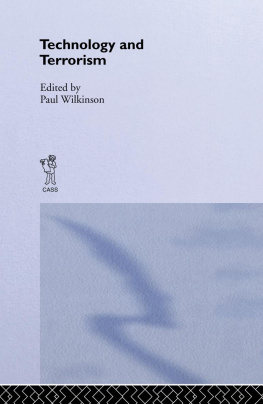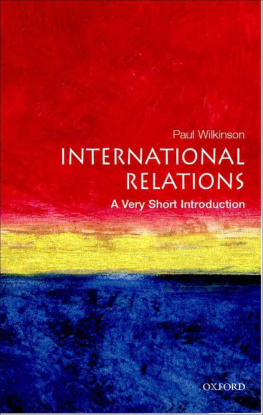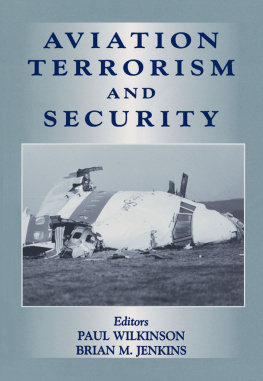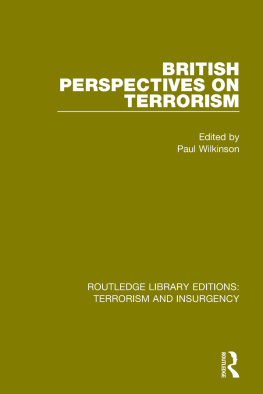TECHNOLOGY AND TERRORISM
Technology and Terrorism
Edited by
Paul Wilkinson
First published 1993 in Great Britain by
Frank Cass & Co. Ltd.
2 Park Square, Milton Park,
Abingdon, Oxon, OX14 4RN
and in the United States of America by
Frank Cass
270 Madison Ave
New York NY 10016
Transferred to Digital Printing 2005
Copyright 1993 Frank Cass & Co. Ltd.
British Library Cataloguing in Publication Data
Technology and Terrorism. - (Terrorism &
Political Violence Series, ISSN 0954-6553;
No.5)
I. Wilkinson, Paul II. Series
322.4
ISBN 0-7146-4552-4
Library of Congress Cataloging-in-Publication Data
Technology and terrorism / edited by Paul Wilkinson.
p. cm.
Includes bibliographical references and index.
ISBN 0-7146-4552-4: $35.00
1. Terrorism Prevention. 2. Terrorism Technological
innovations. 3. Terrorism Security measures. 4. Weapons.
HV6431.T433 1993
363.32 dc20 93-28481
CIP
This group of studies first appeared in a Special Issue on 'Technology and Terrorism' of Terrorism and Political Violence , Vol.5, No.2 (Summer 1993), published by Frank Cass & Co. Ltd.
All rights reserved. No part of this publication may be reproduced in any form or by any means, electronic, mechanical, photocopying, recording or otherwise, without the prior permission of Frank Cass and Company Limited.
Typeset by SX Composing Ltd, Rayleigh, Essex
Contents
| Paul Wilkinson |
| Bruce Hoffman |
| Jimmie C. Oxley |
| Andrew Loehmer |
| Rodney Wallis |
| John D. Baldeschwieler |
| Paul Wilkinson |
| David Marshall MP |
| G. Davidson Smith |
| Richard Clutterbuck |
It is a sad comment that the publication of a volume of this kind would have been appropriate at any time in the past 25 years. However, in view of the fact that while this work was being prepared for the press the world experienced during spring 1993 the World Trade Center bombing in New York, a second massive IRA bomb in the City of London's key financial district, the assassination of the President of Sri Lanka, and the uncovering of an alleged conspiracy to assassinate former US President George Bush when he visited Kuwait, it is probably an understatement to claim that this volume is particularly timely.
The Editor gratefully acknowledges the assistance of the following, who made the work possible: the Research Institute for the Study of Conflict and Terrorism; University of St Andrews, and the National Strategy Information Council (NSIC), Washington, for co-sponsoring and organizing the 24-26 August 1992 seminar of experts on technology and terrorism held at St Andrews; Dr Roy Godson, Mr Tom Diaz and Mr Eric Singer of NSIC; Mr Frank Brenchley, CMG, Chairman of RISCT, who graciously chaired our sessions; Dr Myles Robertson and Mrs Gina Wilson of the St Andrews Univerity Department of International Relations for their invaluable organizational work; Randal Gray of Frank Cass for his expert copy-editing and assistance in seeing the volume through the press; and last but not least the contributors for their unfailing courtesy and commitment in preparing papers for publication in language which is comprehensible to specialists in other disciplines.
PAUL WILKINSON
The role of technology is crucial to any adequate assessment of terrorism and the measures needed to combat it effectively. This was true in the late nineteenth century, the era when dynamite was the favoured weapon of groups such as Irish Fenians and French anarchists. It is even more true today in the age of Semtex and precision guided munitions (PGMs). Yet there have been very few scholarly publications, even during the recent expansion of research on terrorism, which give serious attention to the relationship between technology and terrorism. involving scientists, and those with expertise in government, intelligence and law enforcement.
In this introduction my task is to identify some of the central questions about the relationship between technology and terrorism which need to be addressed. Many of these are answered in considerable detail in my colleagues' papers. My introduction will confine itself to discussing those wider themes which either went beyond the remit of the specialist contributions or emerged as recurrent themes in the informal discussions both during and following the seminar: what part has technology played in the causes of terrorism? Should it be regarded as an independent or a dependent variable in this context? Have terrorists been primarily innovative or 'conservative' in their use of technologies? Does modern technology tilt the balance in favour of the terrorists in their constant battle to defeat the efforts of the counterterrorist agencies, or vice versa? To what extent does the new technology of counterterrorism (data banks, computerised intelligence systems, etc.) threaten civil liberties? How is technology likely to affect the way terrorists in the future choose their tactics, weapons and targets?
Technology and the Causes of Terrorism
It is important to distinguish terrorism as a particular mode of violence from the specific weapons and tactics used in particular incidents or Yet it would be as silly to blame Nobel for the rise of modern terrorism as it would to lay it at the door of the mass media or the decline of religion.
The fundamental causes of terrorism lie in the bitter ethnic, religious and ideological conflicts and hatreds which spawn such brutal violence, and the power struggles and rivalries of states, Hence all the conditions exist in which terrorism is likely to flourish as a mode of conflict for a long time ahead, perhaps for centuries. In addition to these basic causes there are certainly other exacerbating factors which tend to make terrorism a particularly attractive and accessible method of struggle for many actors in the contemporary international system. Some of these factors are undoubtedly connected with technological developments.
First, the sheer costs and dangers of nuclear and full-scale conventional war are so huge that many state and sub-state actors see big advantages in using low-cost, low-risk, potentially high-yield methods such as terrorism as an alternative instrument of coercion. Second, the vast majority of contemporary conflicts are civil or internal wars in which the sub-state belligerents are often economically and militarily very weak, and terrorism and other forms of low-intensity conflict are often all they can manage to deploy. Third, there are many developments in modern technology which particularly lend themselves to exploitation by terrorists. For example, the development of television satellite links and global communication networks has made it easy for terrorists to relay their 'propaganda of the deed' around the world almost instantaneously. The development of light man-portable automatic weapons with a high rate of fire, portable 'fire-and-forget' missiles and malleable, highly destructive plastic explosives, like Semtex, have provided the terrorist with some powerful firepower, greatly increasing their capability of inflicting serious threats to life and property against a well-armed and sophisticated opponent.
Finally, modern technology has created new vulnerable 'key points' in all industrialized societies. One aspect of modern society which makes it far more vulnerable to terrorism is the location of vast quantities of physical energy in concentrated areas such as nuclear power stations, oil and gas storage depots and the centralization of vast quantities of information in data-processing centres and communication systems.













